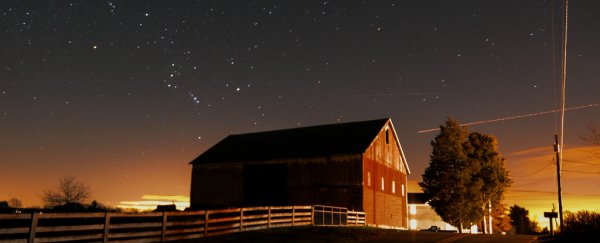If you're an American and you were asked what colour a barn is, your answer would likely be red. It's just tradition. But have you ever stopped to consider why so many of them are painted red in the first place?
There are plenty of ideas out there - maybe it helps cows find their way home (cows are red-green colour blind, so nope), or it helps keep barns warmer in winter. But the reality is actually way cooler - one of the main ingredients in red paint comes from the inside of dying stars, and it's what makes the hue so appealing to farmers.
To be fair, you can actually answer this question two ways: the short answer and the awesome answer.
The short answer is economics. Red paint is traditionally the cheapest paint available, and that's what you need if you're going to be repainting a wooden structure every year, after it battles through tough winters and general wear and tear.
The longer, way more interesting explanation is that the only reason red paint is cheaper than other colours is because of the physics at work inside dying stars.
Yep, the reason barns are painted red is down to what happens when a star reaches its breaking point and dies a glorious, light-filled cosmic death.
How? Well, that was exactly the question posed by engineer and Google employee Yonatan Zunger back in 2013, who took the time to delve into a rabbit hole of economics and physics to figure it out.
In the earliest days of farming, farmers didn't paint their sheds at all – they didn't have the money to spend on it, so they just left them unpainted.
But back in the late-1700s, farmers noticed that their unpainted barns were quickly wearing out from the elements, prompting them to add a protective layer of paint. But paint is expensive, especially when you need to reapply it every season.
So, industrious farmers concocted their own paint from things they could find around their homes.
What they came up with was a combination of iron oxide – which gives clay its copper-red colour – and linseed oil from flax plants. When mixed up and applied to the barns, it turned them that reddish colour we're all familiar with, and kept them protected for longer.
Over the years, more and more farmers joined in, eventually turning to store-bought red paint – specifically, a pigment called red ochre – instead of handcrafted batches, which was still the cheapest option. This leads to the next and most important question: why is red paint so cheap?
Here's where things start to get complicated. Red paint, according to Zunger, is cheap because the elements needed to make it are plentiful here on Earth.
"The red pigment that makes cheap paint is red ochre, which is just iron and oxygen. These are incredibly plentiful: Earth's crust is 6 percent iron and 30 percent oxygen," he explains over at Google Plus.
"Oxygen is plentiful and affects the colour of compounds it's in by shaping them, but the real colour is determined by the d-electrons of whatever attaches to it: red from iron, blues and greens from copper, a beautiful deep blue from cobalt, and so on."
So how did iron, the most important ingredient to our red ochre paint, become so plentiful on our planet? For that, we need to turn to the nuclear fusion reactions happening inside dying stars.
Stars burn thanks to nuclear fusion, a reaction where immense energy causes atoms to fuse together. Since this process consumes atoms to make the energy needed to keep the star together, it will eventually, after billions and billions of years, burn out.
Stars start out using hydrogen as fuel, producing helium as a byproduct. But as they run out of hydrogen and stock up on helium, stars begin to make different elements that weren't possible before.
This is because the stars are shrinking as they run out of fuel, and as they shrink, the pressure and temperature goes up, suddenly allowing them to start all new kinds of reactions.
These new reactions allow stars to fuse heavier and heavier elements, gradually moving up the periodic table until they hit the end point.
This threshold for most stars is 56 nucleons – a fancy way of saying that the star is making things that have a total of 56 protons and neutrons.
At this point, the star lingers because it cannot move up any higher and it still has energy to burn at 56 nucleons. And you might already be guessing it, but what do you think is a stable element at that level? Iron, with its 26 protons and 30 neutrons.
"Once iron is reached, fusion is halted since iron is so tightly bound that no energy can be extracted by fusion," explains a University of Oregon website. "Iron can fuse, but it absorbs energy in the process and the core temperature drops."
That means that once a star gets to the point that all it has left to fuse is iron, it's game over, and generally it has a lot of iron left in its core when it eventually explodes.
And once they explode, all that iron in their cores is scattered out into the rest of the Universe, making up distant planets, such as Earth.
"So it's because of the details of nuclear fusion - the particular size at which nuclei stop producing energy – that iron is the most common element heavier than neon," Zunger concludes.
So, the next time you drive past a red barn, remember that it's actually a connection to our Universe at large.
